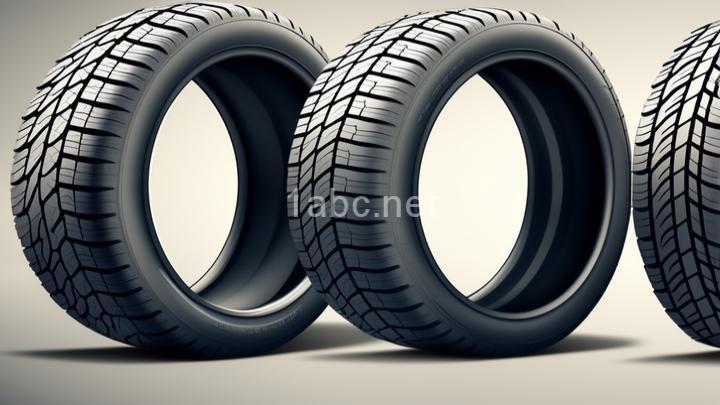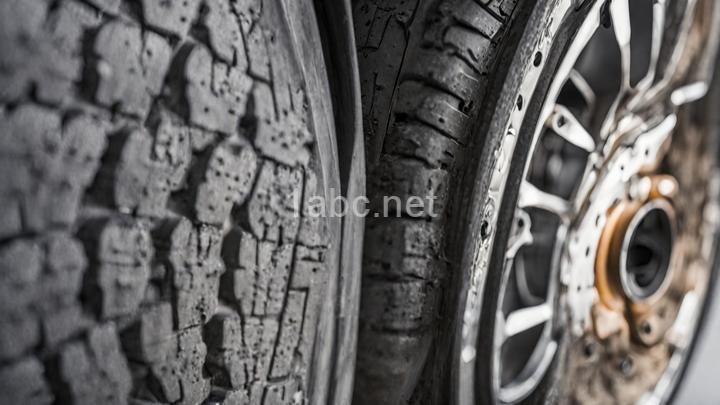The Importance of Tire Tread Depth: What You Need to Know

Introduction:
Have you ever wondered why tire tread depth is so important? Well, buckle up because we're about to dive into the fascinating world of tire maintenance. Did you know that worn-out tire treads can significantly impact your vehicle's safety and performance? It's true! In fact, according to recent statistics, inadequate tire tread depth is a leading cause of accidents on the road. So, let's get into the nitty-gritty of tire tread depth and why it matters.
I. What is tire tread depth?
Tire tread depth refers to the measurement of the grooves in your tires. These grooves play a vital role in maintaining traction on the road, especially in wet or slippery conditions. When your tires have sufficient tread depth, they can effectively grip the road, providing better handling, stability, and overall safety. On the other hand, worn-out tire treads can compromise your vehicle's performance, making it more difficult to stop, turn, or maintain control.
To put it into perspective, imagine trying to walk on an icy surface with worn-out shoes. Your feet would slide and you would struggle to maintain balance, right? Well, the same principle applies to your vehicle's tires. When your tread depth is insufficient, your tires will have trouble gripping the road, increasing the likelihood of accidents.
II. How to measure tire tread depth
Now that we understand the importance of tire tread depth, let's talk about how to measure it. There are a few different methods you can use, depending on your preference and the tools available to you.
One common method is using a tread depth gauge. This handy tool allows you to measure the depth of the grooves accurately. Simply place the gauge into a groove and read the measurement. Repeat this process for multiple spots on each tire to ensure an accurate reading.
If you don't have a tread depth gauge, don't worry! You can still use the trusty old "penny test." Take a penny and insert it into the grooves of your tire with Lincoln's head facing down. If you can see the top of Lincoln's head, it's time to replace your tires. This indicates that your tread depth is too shallow to provide adequate traction.
It's essential to know how to measure tire tread depth accurately, as even a slight difference can affect your vehicle's performance and safety. If you're unsure or want a professional opinion, don't hesitate to visit your local mechanic or tire shop.
III. Signs of worn-out tire treads
Apart from measuring tire tread depth, there are other signs that your tires may need replacing due to worn-out tread:
-
Uneven wear: Take a close look at your tires and check for any uneven patterns of wear. This can indicate alignment issues or other underlying problems that need to be addressed.
-
Low traction: If you notice that your tires are slipping or skidding more frequently, it could be a sign of worn-out treads. This lack of traction can compromise your ability to stop or maneuver safely.
-
Visible bald spots: Inspect your tires for any bald patches or areas where the tread has completely worn away. This is a clear indication that your tires are no longer providing the necessary grip on the road.
It's crucial to pay attention to these warning signs and take immediate action if you notice any of them. Driving on worn-out tires puts you and others at risk, so it's better to be safe than sorry.
IV. The benefits of maintaining proper tire tread depth
Now that we understand the consequences of inadequate tire tread depth, let's talk about the benefits of maintaining proper tread depth:
-
Improved handling: When your tires have sufficient tread depth, they can effectively grip the road, enhancing your vehicle's handling and maneuverability. This means you'll have better control when turning corners, navigating through traffic, or encountering unexpected obstacles.
-
Increased fuel efficiency: Believe it or not, properly maintained tire tread depth can contribute to better fuel efficiency. When your tires have the right amount of tread, they roll more smoothly, reducing resistance and improving your vehicle's overall mileage.
-
Extended tire lifespan: Regularly checking and maintaining your tire tread depth can help prolong the life of your tires. By catching any issues early on and addressing them promptly, you can prevent premature wear and tear, saving you money in the long run.
To drive these points home, let me share a real-life story. Meet Lisa, a cautious driver who always prioritized tire maintenance. One day, while driving on a wet road, Lisa suddenly encountered a slippery spot. Thanks to her well-maintained tires with proper tread depth, she was able to maintain control and safely navigate through the hazardous conditions. Lisa attributes her smooth and safe ride to her commitment to tire care and encourages others to do the same.
V. How often should you check your tire tread depth?
Now that you understand the benefits of proper tire tread depth, you may be wondering how often you should check your tires. The general recommendation is to inspect your tread depth at least once a month. However, certain factors can influence the rate at which your tires wear.
Road conditions, climate, and driving habits all play a role in the lifespan of your tires. If you frequently drive on rough or uneven surfaces, you may need to check your tread depth more often. Similarly, if you live in an area with extreme weather conditions, such as heavy rain or snow, it's wise to be extra vigilant about your tire maintenance.
To make things easier, consider incorporating regular tire checks into your routine vehicle maintenance. For example, you can schedule a monthly reminder to inspect your tires alongside other essential tasks like checking your oil or topping up fluids. By consistently monitoring your tire tread depth, you can stay ahead of any potential issues and ensure your safety on the road.
VI. Tips for preserving tire treads
In addition to regularly checking your tire tread depth, there are several practical tips you can follow to extend the life of your tires' treads:
-
Rotate your tires regularly: Rotating your tires every 6,000 to 8,000 miles helps distribute the wear more evenly, prolonging their lifespan.
-
Maintain proper inflation levels: Properly inflated tires not only improve fuel efficiency but also reduce uneven wear. Check your tire pressure regularly and adjust it according to the manufacturer's recommendations.
-
Avoid aggressive driving habits: Aggressive acceleration, braking, and cornering can cause excessive wear on your tires. Practice smooth and controlled driving techniques to minimize unnecessary strain on your treads.
-
Check alignment regularly: Misaligned wheels can lead to uneven wear patterns on your tires. Have your alignment checked regularly to ensure your tires wear evenly and last longer.
Conclusion:
Congratulations, you've made it to the end of our tire tread depth journey! We've covered everything from what tread depth is to how to measure it, signs of worn-out treads, and the benefits of proper maintenance. By now, you understand the importance of keeping an eye on your tire tread depth and the impact it has on your safety and driving experience.
Remember, regularly checking and maintaining your tire tread depth is crucial for road safety. By following these guidelines, you can ensure that your tires are in optimal condition and enjoy a smoother, safer ride. So, let's make a pact to prioritize tire maintenance and stay tuned for more helpful automotive tips and advice. Together, we can make the roads a safer place for everyone!
FREQUENTLY ASKED QUESTIONS
Why is tire tread depth important?
Tire tread depth is essential for several reasons. First and foremost, it affects your vehicle's traction on the road. As the tread wears down, the tire loses its ability to grip the surface, especially in wet or slippery conditions. This can lead to longer stopping distances and an increased risk of hydroplaning.Furthermore, proper tire tread depth is crucial for maintaining control and stability while driving. With adequate tread depth, the tire can effectively channel water away from the contact patch, reducing the risk of skidding or sliding.
In addition to safety concerns, tire tread depth also affects fuel efficiency. Worn-out tread can cause increased rolling resistance, resulting in decreased fuel economy and higher fuel consumption.
To determine if your tires have sufficient tread depth, you can use a tread depth gauge or the "penny test." Simply insert a penny into the tread grooves with Lincoln's head facing downward. If you can see the top of Lincoln's head, it's time to replace your tires.
Remember, regularly checking and maintaining proper tire tread depth is not only essential for your safety but also for optimal vehicle performance.
How can I measure my tire tread depth?
To measure your tire tread depth, you can use a tire tread depth gauge or the "penny test." Let me explain both methods to you.First, let's talk about the tire tread depth gauge. This handy tool is specifically designed to measure the depth of your tire treads. Simply insert the gauge into the tread grooves and read the measurement on the gauge. Most gauges have a range from 0 to 32/32 of an inch or 0 to 25 millimeters. Make sure to measure the tread depth in multiple spots across the tire to get an accurate reading.
Now, let's move on to the "penny test." This is a simple and cost-effective way to check your tire tread depth. Take a penny and insert it into the tire tread with Lincoln's head facing down. If you can see the top of Lincoln's head, it means your tire tread is too worn and it's time to replace your tires. On the other hand, if the top of Lincoln's head is partially or completely covered by the tread, your tires still have enough tread depth.
Remember, it's important to check the tread depth regularly to ensure your tires have enough grip on the road. Worn-out tires can compromise your safety and vehicle performance. If you find that your tire tread is below the recommended depth, it's best to consult a professional and consider replacing your tires.
I hope this information helps you measure your tire tread depth effectively! If you have any more questions, feel free to ask.
What is the minimum legal tread depth for tires?
The minimum legal tread depth for tires varies depending on the country or region. In many places, the minimum legal tread depth is 1.6 millimeters (mm). It is important to regularly check the tread depth of your tires to ensure they meet the legal requirements for safe driving. Tires with insufficient tread depth can increase the risk of hydroplaning and reduce traction on wet or slippery roads. It's always a good idea to replace your tires before they reach the minimum legal tread depth to maintain optimal safety on the road.
How often should I check my tire tread depth?
To ensure your safety on the road, it's important to regularly check your tire tread depth. The frequency of these checks depends on a few factors, such as your driving habits, the type of tires you have, and the road conditions you encounter. As a general guideline, it's recommended to inspect your tire tread depth at least once a month.You can use a tread depth gauge or the penny test to measure the depth of your tire treads. The penny test is simple: Insert a penny into the tread grooves with Lincoln's head facing down. If you can see the top of Lincoln's head, it's a sign that your tire treads are worn and it's time to replace them.
In addition to monthly checks, it's also important to inspect your tire tread depth before long trips or during seasonal changes. This will help you assess the condition of your tires and ensure optimal traction and performance.
Remember, healthy tire treads are crucial for maintaining grip on the road, especially in wet or slippery conditions. Regularly checking your tread depth will help you identify any potential issues and take necessary action to keep yourself and others safe while driving.

